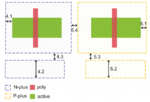yannik33
Member level 1

- Joined
- Oct 18, 2011
- Messages
- 34
- Helped
- 0
- Reputation
- 0
- Reaction score
- 0
- Trophy points
- 1,286
- Activity points
- 1,507
Why differentiate VLSI-Systems between active and n+ resp. p+ ? If the p+ region is larger doesn't this increase the likelihood of an short circuit between drain and source (eg in the figure below there is a connection between drain and source side doesn't this lead to a short circuit?)?

(**broken link removed** ,p. 7)

(**broken link removed** ,p. 7)
